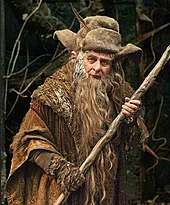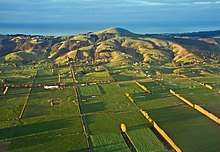Radagast
Radagast the Brown is a wizard in J. R. R. Tolkien's fictional Middle-earth. He appears briefly in The Hobbit, The Lord of the Rings, The Silmarillion, and Unfinished Tales.
| Radagast the Brown | |
|---|---|
| Tolkien character | |
| In-universe information | |
| Aliases | Aiwendil |
| Race | Maiar (wizards) |
| Book(s) | The Hobbit 1937 The Fellowship of the Ring 1954 The Silmarillion 1977 Unfinished Tales 1980 |
His role in Tolkien's writings is so slight that it has been described as a plot device. He played a more significant role in Peter Jackson's The Hobbit film series, where he was portrayed by Sylvester McCoy. Some aspects of his characterisation were invented for the films, but the core elements of his character, namely communing with animals, skill with herbs, and shamanistic ability to change his shape and colours, are described by Tolkien. He also features in role-playing computer games based on Tolkien's writings.
Appearances
Unfinished Tales explains that Radagast, like the other Wizards, came from Valinor around the year 1000 of the Third Age of Middle-earth and was one of the Maiar. His original name was Aiwendil, meaning bird-friend in Tolkien's invented language of Quenya. The Vala Yavanna forced the wizard Saruman to accept Radagast as a companion, which, Tolkien says, may have been one of the reasons Saruman was contemptuous of him, to the point of scornfully calling him "simple" and "a fool".[T 1] However, he was an ally and confidant of Gandalf, who describes him in The Hobbit as his "cousin". He was also friends with the skin-changer Beorn, something that Gandalf relied upon to get his party of dwarves and a hobbit accepted by a sceptical Beorn.[T 2][2]
Radagast lived at Rhosgobel on the western eaves of Mirkwood, its name deriving from Sindarin rhosc gobel meaning "brown village".[T 1] Radagast had a strong affinity for—and relationship with—wild animals. It is said he spoke the many tongues of birds, and was a "master of shapes and changes of hue". Radagast is also described by Gandalf as "never a traveller, unless driven by great need", "a worthy Wizard", and "honest".[T 3]
In The Fellowship of the Ring, during the Council of Elrond, Gandalf tells of a previous encounter with Radagast. Radagast was unwittingly used by Saruman to lure Gandalf to his tower of Orthanc, where Gandalf was captured. Fortuitously, Radagast also helped rescue him by sending Gwaihir the eagle to Orthanc with news of the movements of Sauron's forces. When Gwaihir saw that Gandalf was imprisoned on the top of the tower he carried him off to safety.[T 3]
The only other reference to Radagast in The Lord of the Rings is after the Council of Elrond when scouts are sent out. It is reported that Radagast is not at his home at Rhosgobel.[T 4]
The Silmarillion briefly summarizes the same events in Of the Rings of Power and the Third Age, stating that Radagast was "the friend of all birds and beasts",[T 5] and noting that he innocently helped Saruman to assemble "a great host of spies"[T 5] including many birds.[T 5]
Etymology and origins
The in-fiction etymology, according to the essay The Istari in Unfinished Tales, is that the name Radagast means "tender of beasts" in Adûnaic, another of Tolkien's fictional languages. However, Christopher Tolkien says that his father intended to change this derivation and bring Radagast in line with the other wizard-names, Gandalf and Saruman, by associating it with the old language of the Men of the Vales of Anduin. No alternative meaning is provided with this new association; indeed, Tolkien stated that the name was "not now clearly interpretable". His title The Brown is simply a reference to his earth-brown robes; each of the wizards had a cloak of a different colour.[T 1]
The name Radagast in reality is found in Edward Gibbon's 1776–1789 Decline and Fall of the Roman Empire, in the form "Radagaisus".[3] Slavic mythology contains a god named Radegast; this has been interpreted as "welcome guest", making him the god of hospitality.[4] Tolkien's wizard may represent an echo of this Slavic tradition,[5] a rare source among all the diverse influences on Tolkien's writings.[2]
Tolkien wrote that Josef Madlener's "Der Berggeist", which shows a man in a hat seated in a forest, communing with a wild deer, inspired his Gandalf[6] and set him thinking about the wizards Gandalf, Saruman, and Radagast.[7]
Interpretations
Radagast appears so briefly that he has been described as a plot device for Saruman's treachery, rather than a genuine character. From the clues given, that he is a "master of shapes and a changer of hues", his friendship and communication with animals, and his skill in herbs, he resembles a shaman.[1][2] He has been described as "one of the most interesting enigmas in Tolkien's writings"; given the treason of Saruman, he and Gandalf are the only two wizards available to counter Sauron, but Radagast for some reason fails to answer Elrond's call.[8]
In a letter, Tolkien wrote that Radagast gave up his mission as a Wizard by becoming too obsessed with animals and plants. He added that he did not believe that Radagast's failure was as great as Saruman's.[T 6] This would explain why Radagast disappears abruptly from the plot of Lord of the Rings: he has fallen from his mission on Middle-earth, and has no further part to play in defeating Sauron. The poem in Unfinished Tales about the Istari supports this, saying that only one (Gandalf) went back to Valinor, the others including Radagast and Saruman having failed.[T 1][2] However, Christopher Tolkien notes that Radagast might not have failed completely, as he was specifically chosen by the Vala Yavanna, perhaps on a mission to protect the plants and animals.[T 1]
Adaptations
In film

In Jackson's The Hobbit: An Unexpected Journey, the character is played by Sylvester McCoy,[10] and is expanded far beyond the brief role in the book.[9] McCoy stated that he saw Radagast as "very otherworldly with, as Tolkien depicts him, an empathy and kinship with nature, a Middle-earth version of St Francis of Assisi". McCoy added that while Radagast was rather absent-minded and inclined to forget things, he comes out as "a bumbling hero". As for his house, McCoy said that the idea was that the tree decided to grow right through it, and Radagast agreed that he and the tree could live together.[9] In the film, Radagast is the first wizard to visit Dol Guldur after he realizes that an evil power has infected the wood in which he lives. He discovers that a Necromancer (Sauron) has taken residence in the ruined fortress. In Dol Guldur he encounters the spirit of the Witch-king of Angmar, as well as the shadow of the Necromancer himself, and escapes with the Morgul blade taken from the Witch-king.[9] Radagast's means of transportation is a sled pulled by enormous rabbits, a concept entirely original to the movie.[9] Radagast meets Gandalf, Bilbo, and the Dwarves en route to Erebor, and tells them of his discovery in Dol Guldur. When Thorin's Company are attacked by Orcs riding Wargs, Radagast mounts his sled and provides a distraction. Later, Saruman makes contemptuous remarks about Radagast during a meeting with Gandalf, Elrond, and Galadriel.[11] The writer Brian Sibley comments that the fact that Tolkien said little about Radagast gave Jackson's screenwriters freedom to make of the character what they liked.[9] The Economist wrote that Radagast the Brown had been created from Tolkien's "sparse and bare" hints as to his character.[12] The sled chase was filmed in the Strath Taieri glacial valley of New Zealand's South Island, strewn with real boulders.[13]

In The Hobbit: The Desolation of Smaug, Radagast appears with Gandalf in a few scenes. The two wizards investigate an empty tomb, determining that the Nazgûl are once again awake and have been summoned. Gandalf bids Radagast to go and tell Galadriel of all they find, and that the White Council must make a pre-emptive move on Dol Guldur. Inside the ruins, Gandalf confronts the Necromancer and finds that he is indeed Sauron, just as Radagast had thought.[14]
In The Hobbit: The Battle of the Five Armies Radagast arrives in Dol Guldur as the White Council battle Sauron and the Nazgûl, and carries the wounded Gandalf on his sled.[15]
Other
Radagast features also in computer and video games such as those from Games Workshop.[16] He plays an expanded role in the massively multiplayer online role-playing game Lord of the Rings Online, which makes him a leader in a part of Middle-earth, allowing players to interact with him.[17][18]
References
Primary
- This list identifies each item's location in Tolkien's writings.
- Unfinished Tales, part 4, ch. 2 "The Istari"
- The Hobbit, ch. 7 "Queer Lodgings"
- The Fellowship of the Ring, book 2, ch. 2 "The Council of Elrond"
- The Fellowship of the Ring, book 2, ch. 3 "The Ring Goes South"
- The Silmarillion, Of the Rings of Power and the Third Age
- Letters, #156 to Robert Murray, S.J., 4 November 1954
Secondary
- Harvey, Greg (2011). The Origins of Tolkien's Middle-earth For Dummies. John Wiley & Sons. pp. 159–160. ISBN 978-1-118-06898-4.
- Birns, Nicholas (2007). "The Enigma of Radagast: Revision, Melodrama, and Depth". Mythlore. 26 (1): 113–126.
- Shippey 2005, p. 396.
- Aitamurto, Kaarina; Simpson, Scott (2014). "Modern Pagan and Native Faith Movements in Central and Eastern Europe". Routledge. p. 356.
- Orr, Robert (1994). "Some Slavic Echos in J. R. R. Tolkien's Middle-earth". Germano-Slavica. 8: 23–34.
- Carpenter, Humphrey (1977). J.R.R. Tolkien: a biography. Allen and Unwin. p. 51. ISBN 9780049280373.
- Hammond & Scull 2005, pp. 240-245.
- Winick, Stephen (5 March 2013). "In Defense of The Hobbit: An Unexpected Journey". HuffPost. Retrieved 4 June 2020.
- Sibley 2012, pp. 130–135.
- "Sylvester McCoy is Radagast the Brown". Filmonic. 27 October 2010. Archived from the original on 4 October 2011. Retrieved 3 April 2011.
- Holston & Winchester 2018, pp. 130-132.
- "Prospero" (11 December 2012). "An unexpected disappointment". The Economist. Retrieved 4 June 2020.
- "The Hobbit: An Unexpected Journey 2012". Movie Locations. Retrieved 4 June 2020.
- Holston & Winchester 2018, pp. 132-133.
- "The Hobbit: The Battle of the Five Armies Quotes – 'Will you follow me, one last time?'". Movie Quotes and More. Retrieved 19 June 2020.
- Robb, Brian J.; Simpson, Paul (2013). Middle-earth Envisioned: The Hobbit and The Lord of the Rings: On Screen, On Stage, and Beyond. Race Point. p. 90. ISBN 978-1-937994-27-3.
- Voorhees, Gerald A.; Call, Joshua; Whitlock, Katie (2012). Dungeons, Dragons, and Digital Denizens: The Digital Role-Playing Game. Continuum International. p. 123. ISBN 978-1-4411-9518-0.
- Tresca, Michael J. (2014). The Evolution of Fantasy Role-Playing Games. McFarland. p. 38. ISBN 978-0-7864-6009-0.
Sources
- Carpenter, Humphrey, ed. (1981), The Letters of J. R. R. Tolkien, Boston: Houghton Mifflin, ISBN 0-395-31555-7
- Hammond, Wayne G.; Scull, Christina (2005). The Lord of the Rings: A Reader's Companion. HarperCollins. ISBN 978-0-00-720907-1.
- Holston, Kim R.; Winchester, Tom (2018). Science Fiction, Fantasy and Horror Film Sequels, Series and Remakes: An Illustrated Filmography, Volume II (1996-2016). McFarland. ISBN 978-0-7864-9685-3.
- Shippey, Tom (2005) [1982]. The Road to Middle-Earth (Third ed.). HarperCollins. ISBN 978-0261102750.
- Sibley, Brian (2012). The Hobbit: An Unexpected Journey Official Movie Guide. Houghton Mifflin Harcourt. ISBN 0-547-89930-0.
- Tolkien, J. R. R. (1937), Douglas A. Anderson (ed.), The Annotated Hobbit, Boston: Houghton Mifflin (published 2002), ISBN 0-618-13470-0
- Tolkien, J. R. R. (1954), The Fellowship of the Ring, The Lord of the Rings, Boston: Houghton Mifflin (published 1987), ISBN 0-395-08254-4
- Tolkien, J. R. R. (1977), Christopher Tolkien (ed.), The Silmarillion, Boston: Houghton Mifflin, ISBN 0-395-25730-1
- Tolkien, J. R. R. (1980), Christopher Tolkien (ed.), Unfinished Tales, Boston: Houghton Mifflin, ISBN 0-395-29917-9

.jpg)